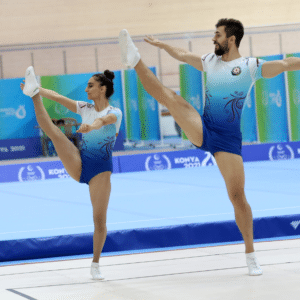Aerobic Gymnastics is a dynamic and challenging sport that requires exceptional strength, endurance, and flexibility. This guide provides a detailed overview of the elements and techniques involved in this exciting discipline.
It may be one of the lesser-known gymnastics disciplines but it is governed by the FIG and practiced by thousands around the globe.
Aerobic Gymnastics elements are classified into four categories: strength, dynamic strength, jumps and leaps, and flexibility. They are all brought together with the seven basic steps of aerobics to create high-intensity aerobic routines.
Let’s find out more!

Table of Contents
Aerobic gymnastics is a sport that combines elements of gymnastics, dance, and fitness. It involves a high-intensity routine that incorporates music and choreography. Aerobic gymnastics was first introduced in the 1980s as a competitive sport and has since gained popularity worldwide.
Now, let’s focus on the seven basic steps of aerobic gymnastics. These essential moves are the foundation of any routine and are crucial to master in order to excel in the sport.
Seven basic steps of aerobic gymnastics
The types of basic steps of aerobic gymnastics glue the more specific elements together. These steps are not super difficult compared with the strength and flexibility elements but they do have to be performed with style and flair in sync with the music.
March
The march is a simple step that involves lifting and lowering each leg in place while keeping the arms at the sides. The key to a great march is to maintain a steady rhythm and maintain proper posture throughout the movement.
Jog
The jog involves running in place while lifting the knees up high. To execute a proper jog, the athlete must maintain an upright posture, land softly on the balls of their feet, and maintain a consistent tempo.
Skip
The skip is a more complex movement that combines a hop and a step. The athlete must propel themselves off one foot and land on the other while lifting the opposite knee up. To perform a proper skip, the athlete must maintain balance, keep the arms moving in rhythm, and use a controlled, explosive movement.
Knee Lift
The knee lift involves lifting one knee up towards the chest while keeping the other leg planted on the ground. The athlete must maintain an upright posture and keep their arms moving in coordination with the movement.
Kick
The kick involves extending one leg out in front of the body while keeping the other leg planted on the ground. The key to a great kick is to maintain proper posture, keep the arms moving, and execute a controlled, explosive movement.
Jack
The jumping jack is a classic exercise that involves jumping with the legs spread wide and then returning them to a standing position. To perform a proper jumping jack, the athlete must maintain proper posture, keep the arms moving in rhythm, and use a controlled, explosive movement.
Lunge
The lunge involves stepping one leg forward and lowering the body into a squat position while keeping the other leg straight behind. The athlete must maintain balance, keep the arms moving, and execute a controlled, explosive movement.
Aerobic gymnastics elements
Aerobic gymnastics elements are types of moves that are included in routines in combination with the basic steps outlined in the previous section. These types of elements require specific training, strength and conditioning just like many other types of gymnastics skills in other disciplines.
Static Strength
Static strength exercises show off the gymnast’s ability to hold specific body positions such as Planche, levers and support shapes.
These body positions are also common in other gymnastics disciplines such as Artistic floor routines.
Upper body and core strength are key to mastering the more advanced aerobic gymnastics strength moves.
Dynamic strength
Dynamic strength exercises are characterized by explosive movements that require power, speed, and control.
The dynamic strength category includes exercises such as pushups, dips, and squats, which are performed with high energy and intensity. These exercises build strength in the upper body, lower body, and core, which is essential for executing other elements in the routine.
Jumps and leaps
Jumps and leaps require a combination of strength, power, and flexibility. They involve executing high jumps and graceful leaps, often combined with twists and turns, that require precise timing and coordination.
Examples include straddle jumps, tuck jumps, and split leaps, which are performed with maximum height and extension.
Balance and flexibility
Flexibility elements include gymnastics moves often seen in women’s artistic routines such as scale and passe and with spins and turns included.
Gymnasts need a good range of motion in the hips and legs in order to extend the legs into the required position. This can often take months and years of flexibility training to achieve the level needed to reach the top of the sport.
Aerobic gymnastics routines
In order to create a great aerobic gymnastics routine, it is important to incorporate a variety of these basic steps and other aerobic gymnastics skills and elements. A great routine should also incorporate music and choreography that syncs with the movements.
In order to excel at aerobic gymnastics, it is important to practice each of the basic steps and elements until they become second nature. Athletes should also focus on maintaining proper posture and executing each movement with power and control. With consistent practice and dedication, anyone can master the seven basic steps of aerobic gymnastics and become a successful athlete in the sport.
